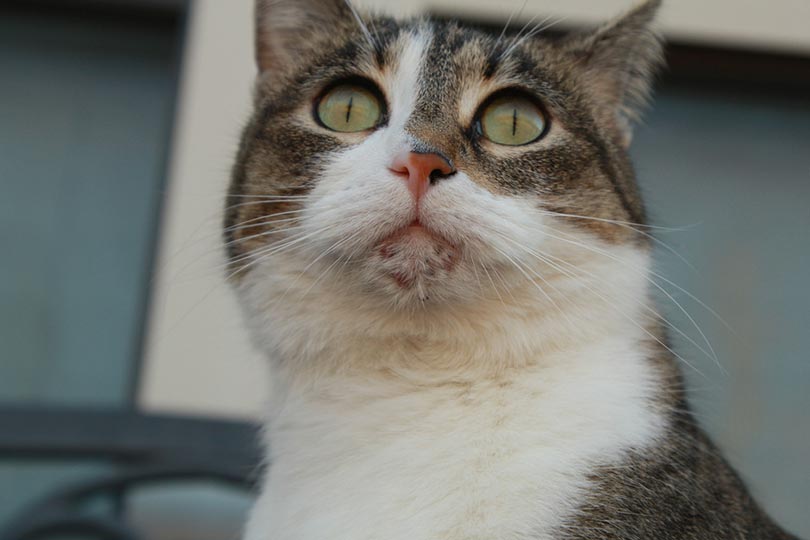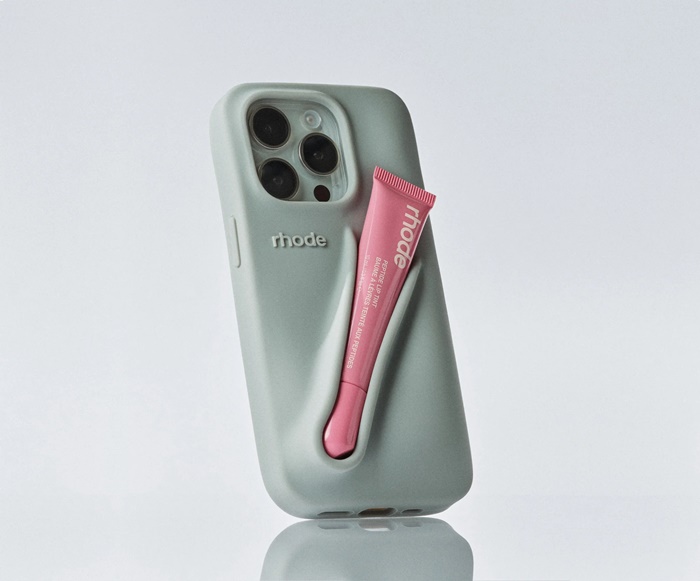
The information is current and up-to-date in accordance with the latest veterinarian research.
Learn more »
Cats can develop acne just like humans do. Lots of owners do not even realize that the little black spots, red bumps, and scabby patches under their cat’s chin have a technical term. Cat acne is caused by the overproduction of a protein found on the top layer of a cat’s skin called keratin. Keratin blocks the pores and causes a build-up of debris resulting in blackheads.
Some cats only suffer from very mild clinical signs, in other cats it can develop into large weeping lesions that require aggressive medical management. If you have noticed black patches, redness, or scabs on your cat’s chin and want to know more about cat acne, this article is for you.
What Is Cat Acne?
Feline acne is a common condition often seen in cats. It can be very subtle with only minimal lesions or severe and widespread. it often appears as red dots, small raised bumps, or black marks on your cat’s face—usually concentrated on their chin. Cat acne goes by the official name of follicular keratinization. It is a poorly understood disorder. It occurs when hair follicles on your cat’s face become blocked due to excessive production of a protein found in the outer layers of the skin called keratin.
Excess keratin gets trapped in the hair follicle allowing for the formation of comedones (commonly known as blackheads). Bacteria can then infect the comedones which leads to pustules that can burst and spread. Cat acne progresses as the hair follicles become inflamed (folliculitis) and furunculosis occurs where large areas are affected by big sores that look like boils. Cats often scratch the lesion, which exacerbates the situation by causing even more pain and inflammation, and introduces more bacteria from their claws and the rest of their face and mouth.
The usual hot spot for this problem is the cat’s chin, giving it the term cat chin acne. Feline acne can appear as small swellings or bumps alongside whiteheads and blackheads. On some cats, it can just look like they have a dirty chin so watch out for this.
In severe cases, there can be substantial hair loss, redness, bleeding, and pus with weepy sores. It can become debilitating for cats. Some cats can just have an isolated bout of acne once in their life. Others unfortunately suffer from chronic episodes that recur frequently and require complex management.
Cats can be affected at any age. Unlike acne in humans, it is not thought to be linked to hormones. Males and females are both affected and neutering cats does not appear to have an influence on the development of acne.
Image Credit: Kristi Blokhin, Shutterstock
What Are the Signs of Cat Acne?
Clinical signs vary greatly depending on the severity of the condition and if there are any concurrent skin diseases or underlying health conditions. Some cats also cause a great deal of trauma by itching and scratching themselves.
The most commonly seen clinical signs are usually on or around the chin and include:
Appearance of dirt on the chin
Appearance of dirt on lips
Blackheads
Whiteheads
Red bumps
Redness on chin
Scabs
Pustules
Furuncles
Swelling
Discharge/weepy wounds
Hard crusty scabs
Pain when touched
Cats can also become very irritated by the lesions caused by cat acne, so they may begin to scratch themselves incessantly as if they have fleas, or they may start to rub their chin on objects. If you notice any of these sorts of behaviors, it is definitely time to get your cat checked out by your vet.
What Are the Causes of Cat Acne?
The exact cause of feline acne is not well understood. It has been suggested that a primary seborrheic disease such as excessive sebum production may be related to abnormal follicular keratinization.
It is also believed that factors such as allergies, stress, infections, inadequate grooming practices, and immunosuppression all contribute to the development of the disease. Currently, there is no research proving any of these things to be the cause of cat acne. It has been suggested some husbandry methods such as using plastic water dishes can predispose cats to acne due to the abrasive surface of the plastic constantly rubbing on cat’s chins while they feed and drink. This may make the skin more prone to infections and may cause the hair follicles to become blocked more easily.
What we do know is that once there is excessive keratin production, the keratin becomes trapped on the surface of the skin, and this alters the environment and causes blackheads to form. The blackheads become infected with bacteria and pustules start to develop. Other factors will contribute to the manifestation and development of acne.
These include:
Age
Size
Body condition score
Underlying systemic health issues
Concurrent skin issues
Grooming habits (older cats won’t be able to groom themselves as well)
Type of water and food bowls used
Image Credit: sophiecat, Shutterstock
Diagnosis of Cat Acne
Diagnosis of cat acne is usually based on clinical signs and the history given by the owner. Your vet will examine your cat and look at their skin all over, not just around their face. Sometimes your vet will take samples from lesions on the skin for culture and sensitivity, cytology, or histopathology. This is also useful for ruling out other causes of the clinical signs such as parasites or a different common skin condition in cats called eosinophilic granuloma complex.
Your vet may also perform routine blood tests and urinalysis to check the general health status of your cat. Occasionally X-rays and ultrasound scans may be carried out if there is substantial swelling involving the jaw as this could be a sign of dental disease or a tumor and these need to be ruled out.
How Do I Care for a Cat with Acne?
Treatment of cat acne is centered around removing the bacteria from the skin and improvement of hygiene in general. If there are specific organisms isolated from the skin, such as bacteria or fungi, the appropriate medication will be provided based on culture and sensitivity results.
Topical shampoos and creams can be used to clean the affected area and remove debris and excess keratin from the hair follicles. Benzoyl Peroxide cream is commonly used in various formations. There are topical antibiotic creams that are sometimes indicated as well. Corticosteroids are often indicated to reduce inflammation.
There have been suggestions that supplementing with omega-3 fatty acids can help.
Other practical measures such as using metal or porcelain food bowls and keeping hair clipped short can help too. It is important that owners do not pick at the lesions caused by cat acne. This will exacerbate the situation and make it worse. This can cause even more discomfort and distress for your cat.
Depending on the nature of the disease, and how severe the condition is, some cats may start on oral and topical creams used in conjunction with shampoos or wipes. As the lesions start to improve, treatment can be tapered off until an outbreak occurs again. Some cats will require a strict maintenance routine to prevent the hair follicles from becoming blocked.
Maintenance cleaning with wipes or a mild shampoo is often an effective way of keeping the skin clear and negating the use of more aggressive treatments such as antibiotics. With some cats, it can help to clip the fur away from their chin as this stops it from getting matted and clogged with dirt. There are specific cat face wipes on the market that contain benzoyl peroxide which are effective. Ensure you do not use human wipes as these are too harsh for cats.
Clean food and water bowls regularly and avoid the use of plastic. Metal or ceramic dishes are thought to be better than plastic for cats that are suffering from acne.
Frequently Asked Questions (FAQ)
Is cat acne painful?
Cat acne can be painful depending on the severity of the condition. The overproduction of keratin is not painful. However, inflammatory changes and the introduction of secondary bacterial infections can cause a great deal of pain and discomfort. As can furunculosis and folliculitis. Your cat may try to itch themselves or rub their chin on objects, this also can be very painful. Mild cases of acne tend to not cause as much disruption and can even pass unnoticed by owners.
Image Credit: eremeevdv, Shutterstock
Can cat acne go away on its own?
Some cases of mild acne can resolve on their own. More severe cases and cases where the follicles become infected will require treatment and regular checkups. Small lifestyle changes can be made in the home that may help resolve the situation, such as changing from plastic water and food bowls and improving hygiene.
Can cat acne be passed on to other cats?
Cat acne is not contagious. The development of cat acne is thought to start from blocked follicles on the cat’s chin. Secondary bacterial infections could potentially be passed from cat to cat, but cat acne cannot as it is due to the overproduction of keratin.
Conclusion
Cat acne is a common problem witnessed in our feline friends. Some cats only suffer from very mild bouts and the acne will resolve on its own without veterinary intervention. Other cats have chronic issues and require complex and aggressive treatments and multiple visits to the vet. Although clinical signs can be severe, cat acne only affects the skin, there are no systemic signs.
If your cat is experiencing recurring cases of cat acne, improving hygiene practices, and changing from plastic water and food bowls to metal or ceramic ones can make a big difference.
Featured Image Credit: Melissa Tate, Shutterstock






